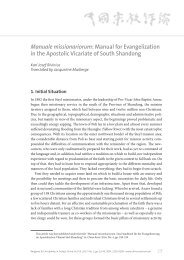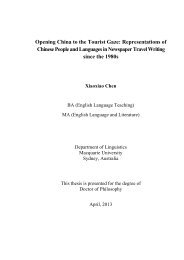EDUCATION IN CHINA
Education-in-China-a-snapshot
Education-in-China-a-snapshot
Create successful ePaper yourself
Turn your PDF publications into a flip-book with our unique Google optimized e-Paper software.
Chapter 1 – Organisation and management of education in China<br />
central government develops policies that serve as<br />
general guidelines, while the local governments develop<br />
more practical policies on how to implement the reform<br />
according to their different circumstances.<br />
The State Council provides important leadership in<br />
education. Education is central to China’s deepening<br />
economic and social reforms. A major reform of the<br />
education system may require extensive adjustments of<br />
various sectors of society. Thus, when the reform is ready<br />
for implementation, it is announced by the State Council.<br />
The State Council devises policies and strategies required<br />
by the new reform and transmits these directly to local<br />
governments instead of bureaus of education.<br />
<strong>EDUCATION</strong>AL <strong>IN</strong>SPECTION<br />
The Office of National Education Inspectorate, which<br />
was re-established as a department in the Ministry of<br />
Education in 1986, is the agency that manages national<br />
educational inspection. In 2016, the office was renamed<br />
the Bureau of Education Inspections. It also serves as<br />
the Office of Education Inspection Committee of State<br />
Council. China’s educational inspection system consists<br />
of four administrative levels covering all provinces. The<br />
responsibility of the Bureau of Education Inspections is<br />
not only to monitor and examine the implementation of<br />
state laws, regulations, principles and policies, but also<br />
to evaluate and provide useful feedback to lower-level<br />
governments and institutions. The bureau sets standards<br />
and procedures for inspection, and organises inspections<br />
at every level. In addition, the bureau is responsible for<br />
monitoring and evaluating the quality of different types<br />
of education institutions, as well as setting standards and<br />
procedures for quality evaluation.<br />
After every inspection exercise, comments and feedback<br />
are forwarded to schools or lower-level governments.<br />
In addition, the results of the inspections are publicly<br />
reported. Education quality reports are published, and<br />
they serve as an important reference for the government’s<br />
future work.<br />
Special inspections are conducted according to<br />
the imperatives set by current reforms or in case of<br />
emergencies. At present, four special subjects are<br />
being inspected; three of these subjects are relevant to<br />
compulsory education in rural areas. The first is improving<br />
basic school conditions, like buildings and facilities, in<br />
poor areas. The second subject is equitable development<br />
of compulsory education, aimed at reducing gaps in<br />
performance between rural and urban areas, through<br />
more effective and equitable fiscal transfers. The third<br />
is a nutrition improvement programme for compulsory<br />
education students in rural areas. The last item is the<br />
safety of school buses. This project was undertaken after<br />
several school bus accidents.<br />
China’s educational inspection system itself is being<br />
reformed currently. The reform of the inspection system<br />
is recognised as a breakthrough in transforming the<br />
management role of the government in education. This<br />
reform is also an important means to guaranteeing<br />
the achievement of educational development goals.<br />
Several policies have been adopted that will transform<br />
the inspection system. They are described in Chapter 2.<br />
<strong>EDUCATION</strong> F<strong>IN</strong>ANC<strong>IN</strong>G<br />
AND MANAGEMENT<br />
State budgetary allocation is the main source of funds<br />
for education in China. China’s central treasury and<br />
local treasuries contribute to education funding. This<br />
arrangement is in line with a policy that encourages<br />
diverse resource mobilisation, as delineated in Article 54<br />
of the Education Law.<br />
Investment in the education system in absolute terms<br />
in China has continued to increase at a high rate, as<br />
shown in Figure 1.2. China’s investment in education has<br />
increased at a rate of 19% on average in the last ten years.<br />
This trend of increased investment is due to government<br />
laws and policies. The Education Law requires increased<br />
government appropriations for education at all levels<br />
proportional to the growth of the national economy. The<br />
State Council is tasked with determining the appropriate<br />
proportional increase in government appropriations for<br />
education. Therefore China’s educational expenditure per<br />
student, as well as teacher salaries, should see continued<br />
growth.<br />
Meanwhile, the Educational Law also stipulates that<br />
government appropriation for education as percentage of<br />
GDP should also continue to grow in accordance with the<br />
country’s economic development and revenue growth. As<br />
shown in Figure 1.3, education appropriations reached<br />
the government goal of over 4% of GDP in 2012, which was<br />
set by the National Medium and Long-Term Educational<br />
Reform and Development Programme (2010-2020).<br />
The management of educational funds involves<br />
three major tasks: fundraising, appropriation and<br />
supervision. The Department of Finance within the<br />
Ministry of Education is in charge of these tasks. The<br />
Funds Supervision Affairs Centre within the Ministry<br />
of Education also plays an important role in funds<br />
management.<br />
14 – <strong>EDUCATION</strong> <strong>IN</strong> CH<strong>IN</strong>A: A SNAPSHOT © OECD 2016





